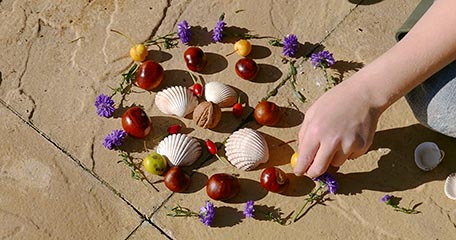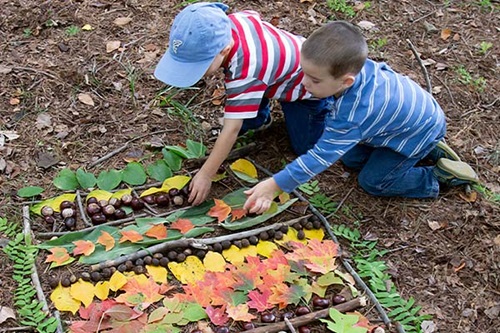Empowering mathematical minds through play
| January 2016The current emphasis on STEM learning and the Common Core State Standards is drawing attention to the importance of maths in early childhood. Research suggests that early maths skills are a more accurate indicator of later academic success than early reading skills (Stipek, Schoenfield, and Gamby 2012). It is important therefore that early childhood teachers are better prepared to teach mathematics. The concern however, is that this emphasis on early childhood maths education may encourage some to fall back on traditional teaching methods (e.g. rote counting and memorisation) that may be easier to use but are quite detrimental to children. Rather than preparing them for maths, they may instead drive them away from their intuitive interest in problem-solving (Hachey 2013).
Early childhood educators can testify to the mathematical activity that children engage in naturally through play. Children building a unifix cube trail across the room to calculate and measure the distance or young chefs following a picture recipe to make a classroom snack are obviously engaging in mathematical activity. Children may naturally demonstrate their intuitive knowledge about maths in the process of play but mathematical proficiency does not just emerge on its own (Copley 2010). For example, children do not necessarily learn to count out change correctly simply by playing with a cash register. Rather, playing at the pretend grocery store can provide an opportunity to learn and teach the concept of counting money in an effective context.
In order to empower these young mathematical minds, it is necessary to provide appropriate scaffolding. The “scaffolding” must be sturdy enough to build knowledge but flexible enough to be removed so the learner is able to function independently. This can only happen when the scaffolding is meaningful and in context. The first step is to intently observe the children’s natural play. The teacher’s aim should be to listen to the children’s process of investigation and see the exploration from their lens.
Once the teacher has observed and assessed the exploration already happening, they should think about ways to make the children’s investigation more meaningful. This kind of purposeful scaffolding promotes respectful relationships that enable children to engage in learning (Chorssen, Church, and Taylor 2014). One way of picturing this is to use mathematical vocabulary: the teacher’s task is to add, subtract, multiply, and divide appropriate resources in a way that will encourage the children to problem-solve on their own.
Adding Resources
Adding materials to sustain interest or generate new interest is an effective way to strengthen mathematical concepts and skills in young learners.
For example, when children showed interest in robots through their play and conversations, the teacher systematically added materials like books, aluminium soup cans with pipe cleaners, and magnet rods. Children picked materials like snap blocks to give 3-dimensional form to the book pictures they were looking at. Soup-can bodies with magnetic rod limbs became popular. The teacher added magnetic triangles. Children used these flat triangles to create 3-dimensional figures. Then they began drawing robots in their journals, returning to 2-dimensional form. The opportunity to work with several different materials to pursue one interest allowed children to explore shapes in different dimensions.
Elkind (2012) addresses the difference between knowing and understanding, in that a child may know that 2+2=4 but may not understand why this statement is true. Similarly, knowing that a shape is called a circle or a triangle suggests nothing about the child’s understanding of the shape and its properties. However, using an existing interest (robots), the teacher created learning opportunities by thoughtfully adding materials to allow children to construct understanding about shapes in relation to space.

Subtracting Resources
Of equal importance to the process of learning is the idea of subtracting or removing materials from a learning centre that may hinder investigation.
In a preschool classroom, children were using pattern blocks to replicate designs on pre-made cards by matching up the shapes. Soon they abandoned the cards and made their own designs. Excited to see this evolution in their play, the teacher expected to see more of it over time. She left the cards on the shelf with the blocks, however, and observed that the children soon reverted to the ready-made cards. So the following day she relocated the cards to another side of the room. In a few minutes, the children had covered up one part of the table with all the different shapes leaving no gaps between the pieces. Some were counting how many pieces it took to cover the space, others were identifying patterns within the larger design, and some learned shape names like “hexagon”. At this point, the teacher introduced the word “mosaic”. The thoughtful removal of the cards reduced the children’s dependency on them and enabled them to go beyond simple shape-matching.

Multiplying Learning Opportunities
When we multiply, the end product is amplified in proportion to the number with which we multiply. In the same way, opportunities for mathematical reasoning are amplified in proportion to children’s original investigations when an adult makes use of teachable moments. In the following documentation of play, notice how children explored the concept of “number” through measurement, geometry, and data collection.
Frequent conversations about building a giant robot led the teacher to introduce measuring tapes with a question: “Where in our room will you put your giant robot?” As they explored the measuring tapes, children realised that there was a number associated with space. Using this teachable moment the teacher introduced the words “length”, ”width”, “height” and ”dimensions”. As disagreement over sizes of the giant robot came about, Kate decided to do a survey and collect data to see how many children wanted one large robot and how many wanted four smaller robots. To help all the students visualise this data the teacher used unifix cubes. It was easy to see that the vote was in favour of one big robot.
The children brought recyclables from home to build their robot. They sorted out the materials and decided to build a “cylinder robot” by selecting the cylindrical materials. One child made a sign to let her peers know that they needed “1 more” soda can for the robot’s arm.
In seizing teachable moments the teacher multiplied the opportunities for mathematical concepts to be explored through measurement, data collection, and geometry. All investigations however, were bound to the initial interest in robots thereby promoting number sense in ways meaningful to the children. Commonly encountered activities in many early childhood settings focus on rote counting. These may teach children the order of numbers but without connection to their world they cannot gain an understanding for the concept of numbers in direct relation to space, objects, or shapes (Stipek et al. 2012).

Dividing Materials
Finally, it is important to divide the materials that stimulate mathematical activity in different areas of the classroom to create a maths-rich physical environment.
Most teachers set up one maths centre in the classroom with materials such as rulers, pattern blocks, etc. and periodically rotate them. Just as mathematical learning is not restricted to one core knowledge area at a time (like measurement or geometry), it is also not restricted to one space like a maths centre. Children learn better when they can make connections to other things they know (Copley 2010).
Physical proximity of materials is suggestive in subtle ways. For example, when graph paper was added to the art shelf, children started tracing objects and counting the number of squares in the outline. Adding stop watches to a marble maze encouraged children to explore the relationship between the dimensions of the maze and time taken by the marble to go through it. Just as reading and writing skills increase when literacy props such as menus are provided in the dramatic play area, so also, props that trigger mathematical activity encourage mathematical thinking.
It is also important to survey the classroom materials to ensure that maths materials are not limited to “numbers” but include opportunities for measurement of space and time, geometry, data collection, and probability. Consider putting calendars and clocks in the pretend play area, assorted sized paper and fabrics in the art area, or dice and clipboards in the writing area.

Conclusion
By providing meaningful scaffolding that builds on children’s interests and intuitive mathematical knowledge, children learn more than concepts and skills. Exploration through play provides children a safe context to create concrete meaning out of abstract numerical and geometric symbols. Copley (2010) discusses the power of positive attitude and motivated disposition in the long-term mastering of mathematics. Among other things, a motivated disposition includes risk-taking and persistence. However, it is important to consider that children lose motivation quickly when maths education becomes about procedures and formulae instead of exploration and hands-on activities.
The whole concept of STEM education has been pushed down from the top where great voids in mathematical proficiency were most noticeable. For this to change, the whole system must change. However, this should not mean pushing down academic standards to early childhood. If anything, a play-based/inquiry-based approach must be “pushed up” to older grade levels!
But systemic change apart, given that through play, children intuitively engage in mathematical activity, respond to meaningful scaffolding, and feel safe taking risks to problem-solve, what is the probability that with a strong commitment to “meaningful scaffolding”, we will empower mathematical minds? I will let you do the maths on that!
References:
Cohrssen, C., A. Church & C. Tayler (2014). Pausing for learning: Responsive engagement in mathematics activities in early childhood settings. Australasian Journal Of Early Childhood 39(4): 95–102.
Copley, J. V. (2010). Young children and Mathematics. Washington D.C.: NAEYC.
Elkind, D. (2012). Knowing Is Not Understanding Fallacies and Risks of Early Academic Instruction. YC: Young Children 67(1): 84–87.
Hachey, A. (2013). Early Childhood Mathematics Education: The Critical Issue is Change. Early Education & Development 24(4): 443–445. doi:10.1080/10409289.2013.777286.
Stipek, D. (2013). Mathematics in Early Childhood Education: Revolution or Evolution? Early Education & Development 24(4): 431–435. doi:10.1080/10409289.2013.777285.
Stipek, D., A. Schoenfeld, & D. Gomby (2012). Math Matters, Even for Little Kids. Education Week 31(26): 27–29.
Acknowledgement:
Many examples included in this article come from Mrs. Meghan Sheil’s preschool classroom at Phyllis and Richard Leet Center for Children and Families, Northwest Missouri State University. Thank you, Mrs. Meghan Sheil, for sharing your expertise.







